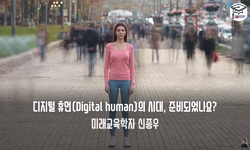(Background and Purpose) Gartner, a global IT research and advisory firm, cited immersion experiences as one of the top 10 strategic technologies for 2019. This implies that a real-like experience is possible in a virtual environment without any const...
http://chineseinput.net/에서 pinyin(병음)방식으로 중국어를 변환할 수 있습니다.
변환된 중국어를 복사하여 사용하시면 됩니다.
- 中文 을 입력하시려면 zhongwen을 입력하시고 space를누르시면됩니다.
- 北京 을 입력하시려면 beijing을 입력하시고 space를 누르시면 됩니다.

VR환경에서 디지털휴먼 얼굴 표현이 현실감에 미치는 요인 분석 = Analysis of Factors Affecting Reality of Digital Human Facial Expression in Virtual Reality Environment
한글로보기https://www.riss.kr/link?id=A107306217
- 저자
- 발행기관
- 학술지명
- 권호사항
-
발행연도
2021
-
작성언어
-
-
주제어
Virtual Reality ; Digital Human ; Realism ; External Expression ; Facial Expression ; 가상현실 ; 디지털휴먼 ; 현실감 ; 외적표현 ; 비정형
-
KDC
600
-
등재정보
KCI등재
-
자료형태
학술저널
- 발행기관 URL
-
수록면
383-391(9쪽)
-
KCI 피인용횟수
0
- DOI식별코드
- 제공처
-
0
상세조회 -
0
다운로드
부가정보
다국어 초록 (Multilingual Abstract)
(Background and Purpose) Gartner, a global IT research and advisory firm, cited immersion experiences as one of the top 10 strategic technologies for 2019. This implies that a real-like experience is possible in a virtual environment without any constraint of time or space. Currently, there is a trend in the industry to produce digital humans with a better sense of reality, based on the textures and shapes that are obtained by taking pictures of real people. This study examines if the degree of reality in both, appearance and facial expressions, affects the sense of reality of digital humans, the level of difference observed, and what are the main influencing factors, by creating a prototype of digital humans from a more industrial perspective. (Method) In this study, existing digital humans have been studied to check wrinkles, skin color, skin texture, individual hair, lighting reflection, and pupil reflection. Experimental research using the produced prototype, was conducted, to identify the impact of both, appearance and facial expressions, on the sense of reality of digital humans, and what are the main influencing factors. The hypothesis was that when the degree of reality in facial expressions was increased by one level, the sense of reality indicated a difference of two or more levels, and asymmetry was the main factor in the facial expressions of digital humans. (Results) It was found that the ratio of overall sense of reality differed by two or more levels, as the degree of reality of the facial expressions in visual reality increased by one level. The main factors were the projection of light on the face, the reflection of the image in the pupils, and the impression of the hair, for the evaluation of the degree of reality of appearance. Additionally, it was confirmed that the main factors to evaluate the degree of reality were the different consequences for repetitive behavior, the irregular blinking of the eyes, and natural muscles. It was found that atypical factors such as harmony, irregularity, and asymmetry were the factors that had an impact on the overall sense of reality. (Conclusions) It was found that the degree of reality in facial expressions affected the sense of reality more than the appearance of digital humans in the virtual reality environment. It was confirmed that atypical factors such as harmony, irregularity, and asymmetry, which are the factors of the degree of reality in facial expressions of digital humans, were the most influencing factors in the overall sense of reality.
참고문헌 (Reference)
1 오준영, "홍성 신경리 마애여래입상의 3차원 기록화를 통한 포토그래메트리의 유용성 연구" 국립문화재연구소 50 (50): 30-43, 2017
2 김우상, "몰입형 가상현실의 아바타 디자인 특성에 관한 연구-소셜네트워크 기반의 가상현실 콘텐츠를 중심으로-" 한국디자인문화학회 24 (24): 91-104, 2018
3 김동준, "디지털 휴먼 모델링 도구를 이용한 작업 개선에 관한 연구" 한국안전학회 23 (23): 51-56, 2008
4 최희경, "가상공간에서 아이덴티티(Identity) 표현 도구로서의 사이버캐릭터에 관한 연구 : 2D 아바타와 3D 아바타의 비교분석을 중심으로" 한국디지털영상학회 5 (5): 113-127, 2008
5 이연빈, "VR에서 디지털 휴먼과 상호작용 시 외형 표현 단계가 사회적 실재감에 미치는 영향" 한국디지털콘텐츠학회 21 (21): 1113-1122, 2020
6 Yoon, Hyunyoung, "VR · AR · MR related technology and policy trends" 2019
7 Yang, Changyoon, "Scan data processing for generating 3D model" 258-259, 2012
8 Kang, Minsung, "Innovative Technology Trends in Intelligent Information Society: Focused on Gartner's'Top 10 Strategic Technology Trend 2019'Report" 30 (30): 17-31, 2018
9 Engerer, Volkmar P., "Information Professionals Going Beyond the Needful User in Digital Humanities Project Collaboration" 한국과학기술정보연구원 8 (8): 6-19, 2020
10 Go, Byungkwan, "Implementation of 3D Face Alignment System" The Institute of Electronics and Information Engineers 605-608, 2012
1 오준영, "홍성 신경리 마애여래입상의 3차원 기록화를 통한 포토그래메트리의 유용성 연구" 국립문화재연구소 50 (50): 30-43, 2017
2 김우상, "몰입형 가상현실의 아바타 디자인 특성에 관한 연구-소셜네트워크 기반의 가상현실 콘텐츠를 중심으로-" 한국디자인문화학회 24 (24): 91-104, 2018
3 김동준, "디지털 휴먼 모델링 도구를 이용한 작업 개선에 관한 연구" 한국안전학회 23 (23): 51-56, 2008
4 최희경, "가상공간에서 아이덴티티(Identity) 표현 도구로서의 사이버캐릭터에 관한 연구 : 2D 아바타와 3D 아바타의 비교분석을 중심으로" 한국디지털영상학회 5 (5): 113-127, 2008
5 이연빈, "VR에서 디지털 휴먼과 상호작용 시 외형 표현 단계가 사회적 실재감에 미치는 영향" 한국디지털콘텐츠학회 21 (21): 1113-1122, 2020
6 Yoon, Hyunyoung, "VR · AR · MR related technology and policy trends" 2019
7 Yang, Changyoon, "Scan data processing for generating 3D model" 258-259, 2012
8 Kang, Minsung, "Innovative Technology Trends in Intelligent Information Society: Focused on Gartner's'Top 10 Strategic Technology Trend 2019'Report" 30 (30): 17-31, 2018
9 Engerer, Volkmar P., "Information Professionals Going Beyond the Needful User in Digital Humanities Project Collaboration" 한국과학기술정보연구원 8 (8): 6-19, 2020
10 Go, Byungkwan, "Implementation of 3D Face Alignment System" The Institute of Electronics and Information Engineers 605-608, 2012
11 Han, Sangyeil, "Global XR policies and implications" SPRI 2020
12 Song, Jongguk, "Future Horizon "VR is Real Life"" STEPI 2016
13 Jong Tae Park, "Digital Color Image Watermarkingfor HVS(Human Visual System) using Daubechies wavelet" 한국정보통신학회 8 (8): 1488-1492, 2004
14 S., Karmakar, "Application of digital human modeling and simulation for vision analysis of pilots in a jet aircraft: a case study" 41 (41): 3412-3418, 2012
15 Matsui, Toshihiro, "(Special Issue Digital Human Technology-Regarding a Human as a System) (Survey) Viewing a Human as a System in the Digital Human Technology" 45 (45): 993-998, 2006
동일학술지(권/호) 다른 논문
-
미국 대학도서관의 그룹스터디룸 이용자 만족도에 관한 연구
- 한국공간디자인학회
- 김준연 ( Kim Junyon )
- 2021
- KCI등재
-
천안, 아산 원도심 상업지역의 도시공간구조 비교 분석 연구
- 한국공간디자인학회
- 이기석 ( Lee Kiseok )
- 2021
- KCI등재
-
건축에서 수직 이동수단의 반복과 공간 연속성의 관계에 관한 연구-게슈탈트 지각이론을 중심으로-
- 한국공간디자인학회
- 신승수 ( Shin¸ Seungsu )
- 2021
- KCI등재
-
- 한국공간디자인학회
- 이종세 ( Yi Jongse )
- 2021
- KCI등재
분석정보
인용정보 인용지수 설명보기
학술지 이력
| 연월일 | 이력구분 | 이력상세 | 등재구분 |
|---|---|---|---|
| 2022 | 평가예정 | 재인증평가 신청대상 (재인증) | |
| 2019-01-01 | 평가 | 등재학술지 유지 (계속평가) |  |
| 2016-01-01 | 평가 | 등재학술지 선정 (계속평가) |  |
| 2015-06-01 | 학술지명변경 | 외국어명 : Journal of the Korea Intitute of the spatial design -> Journal of Korea Intitute of Spatial Design |  |
| 2015-01-01 | 평가 | 등재후보학술지 유지 (계속평가) |  |
| 2013-01-01 | 평가 | 등재후보 1차 FAIL (등재후보1차) |  |
| 2012-01-01 | 평가 | 등재후보학술지 유지 (기타) |  |
| 2011-01-01 | 평가 | 등재후보 1차 PASS (등재후보1차) |  |
| 2009-01-01 | 평가 | 등재후보학술지 선정 (신규평가) |  |
학술지 인용정보
| 기준연도 | WOS-KCI 통합IF(2년) | KCIF(2년) | KCIF(3년) |
|---|---|---|---|
| 2016 | 0.47 | 0.47 | 0.53 |
| KCIF(4년) | KCIF(5년) | 중심성지수(3년) | 즉시성지수 |
| 0.51 | 0.52 | 0.692 | 0.28 |





 KCI
KCI KISS
KISS






